Business Plan for Slider Diner Fast Food Restaurant
VerifiedAdded on 2023/01/23
|15
|3978
|64
AI Summary
This report presents a business plan for Slider Diner, a new fast food restaurant in Australia. The plan focuses on the Business Model Canvas and includes components such as customer segments, value proposition, customer relationships, channels, key activities, key resources, key partners, revenue structure, and cost structure. The target market for the restaurant is children and teenagers, and the goal is to provide affordable fast food items in a comfortable environment.
Contribute Materials
Your contribution can guide someone’s learning journey. Share your
documents today.

Entrepreneurshi
p
Student’s Name:
Student’s ID:
p
Student’s Name:
Student’s ID:
Secure Best Marks with AI Grader
Need help grading? Try our AI Grader for instant feedback on your assignments.
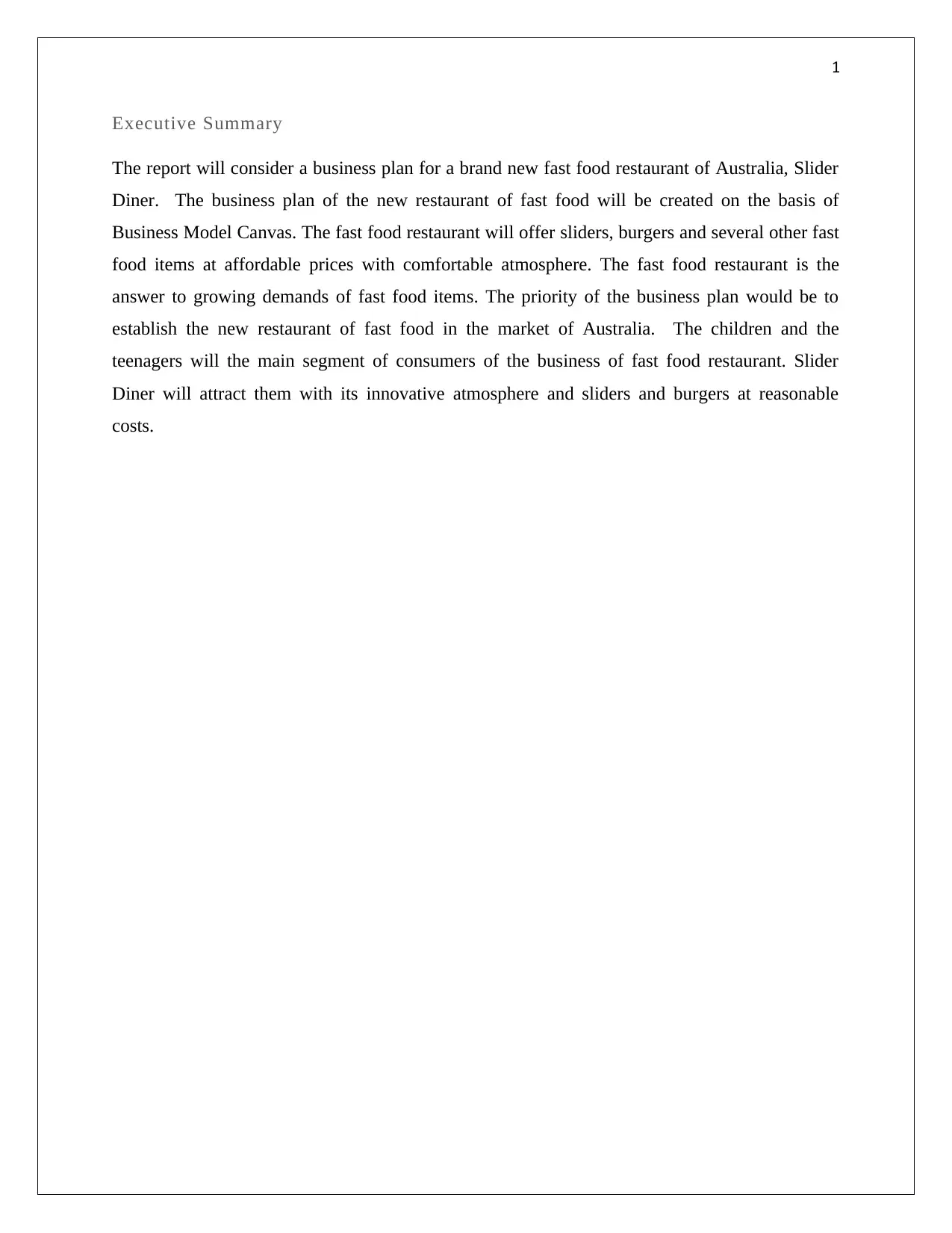
1
Executive Summary
The report will consider a business plan for a brand new fast food restaurant of Australia, Slider
Diner. The business plan of the new restaurant of fast food will be created on the basis of
Business Model Canvas. The fast food restaurant will offer sliders, burgers and several other fast
food items at affordable prices with comfortable atmosphere. The fast food restaurant is the
answer to growing demands of fast food items. The priority of the business plan would be to
establish the new restaurant of fast food in the market of Australia. The children and the
teenagers will the main segment of consumers of the business of fast food restaurant. Slider
Diner will attract them with its innovative atmosphere and sliders and burgers at reasonable
costs.
Executive Summary
The report will consider a business plan for a brand new fast food restaurant of Australia, Slider
Diner. The business plan of the new restaurant of fast food will be created on the basis of
Business Model Canvas. The fast food restaurant will offer sliders, burgers and several other fast
food items at affordable prices with comfortable atmosphere. The fast food restaurant is the
answer to growing demands of fast food items. The priority of the business plan would be to
establish the new restaurant of fast food in the market of Australia. The children and the
teenagers will the main segment of consumers of the business of fast food restaurant. Slider
Diner will attract them with its innovative atmosphere and sliders and burgers at reasonable
costs.
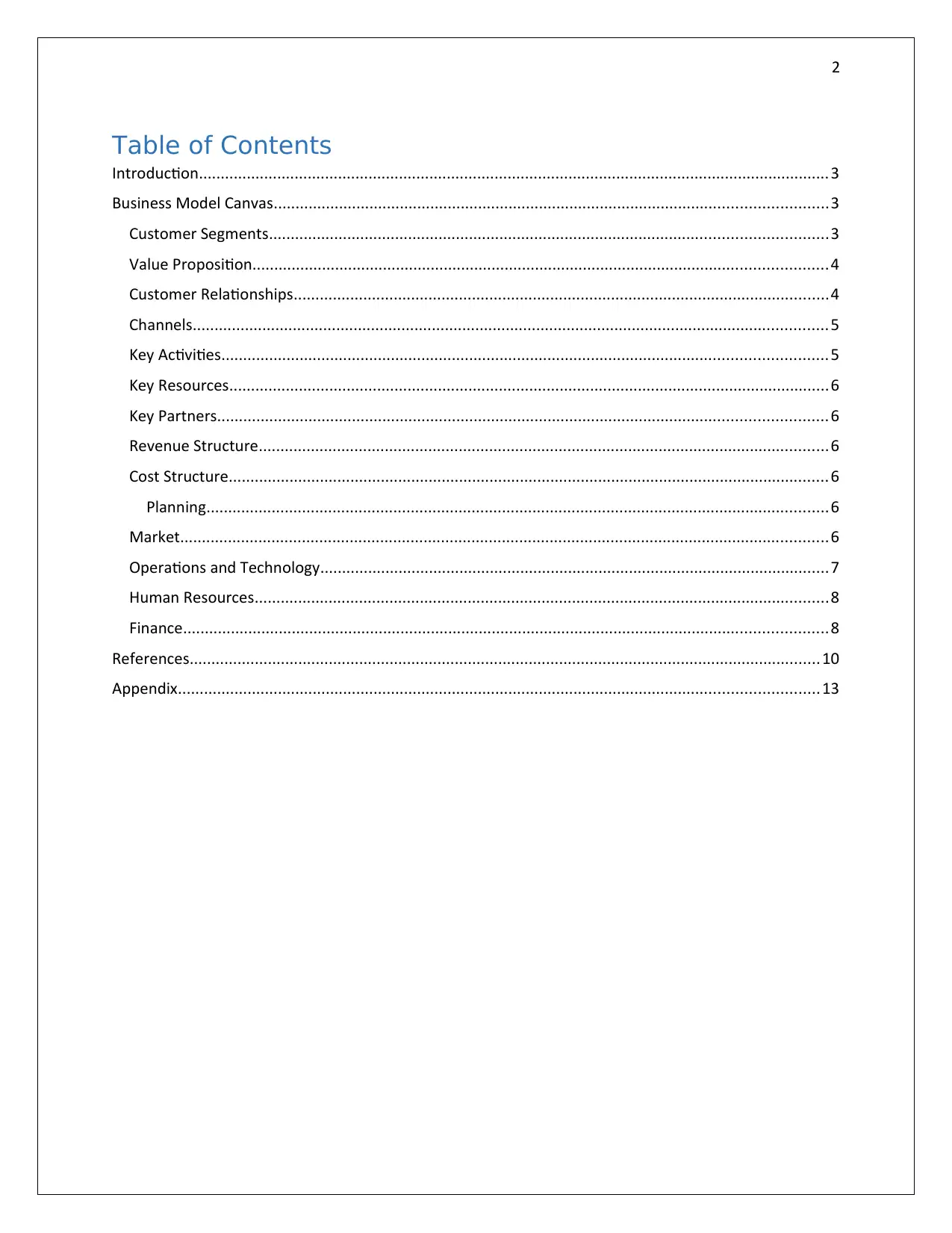
2
Table of Contents
Introduction.................................................................................................................................................3
Business Model Canvas...............................................................................................................................3
Customer Segments................................................................................................................................3
Value Proposition....................................................................................................................................4
Customer Relationships...........................................................................................................................4
Channels..................................................................................................................................................5
Key Activities...........................................................................................................................................5
Key Resources..........................................................................................................................................6
Key Partners............................................................................................................................................6
Revenue Structure...................................................................................................................................6
Cost Structure..........................................................................................................................................6
Planning...............................................................................................................................................6
Market.....................................................................................................................................................6
Operations and Technology.....................................................................................................................7
Human Resources....................................................................................................................................8
Finance....................................................................................................................................................8
References.................................................................................................................................................10
Appendix...................................................................................................................................................13
Table of Contents
Introduction.................................................................................................................................................3
Business Model Canvas...............................................................................................................................3
Customer Segments................................................................................................................................3
Value Proposition....................................................................................................................................4
Customer Relationships...........................................................................................................................4
Channels..................................................................................................................................................5
Key Activities...........................................................................................................................................5
Key Resources..........................................................................................................................................6
Key Partners............................................................................................................................................6
Revenue Structure...................................................................................................................................6
Cost Structure..........................................................................................................................................6
Planning...............................................................................................................................................6
Market.....................................................................................................................................................6
Operations and Technology.....................................................................................................................7
Human Resources....................................................................................................................................8
Finance....................................................................................................................................................8
References.................................................................................................................................................10
Appendix...................................................................................................................................................13
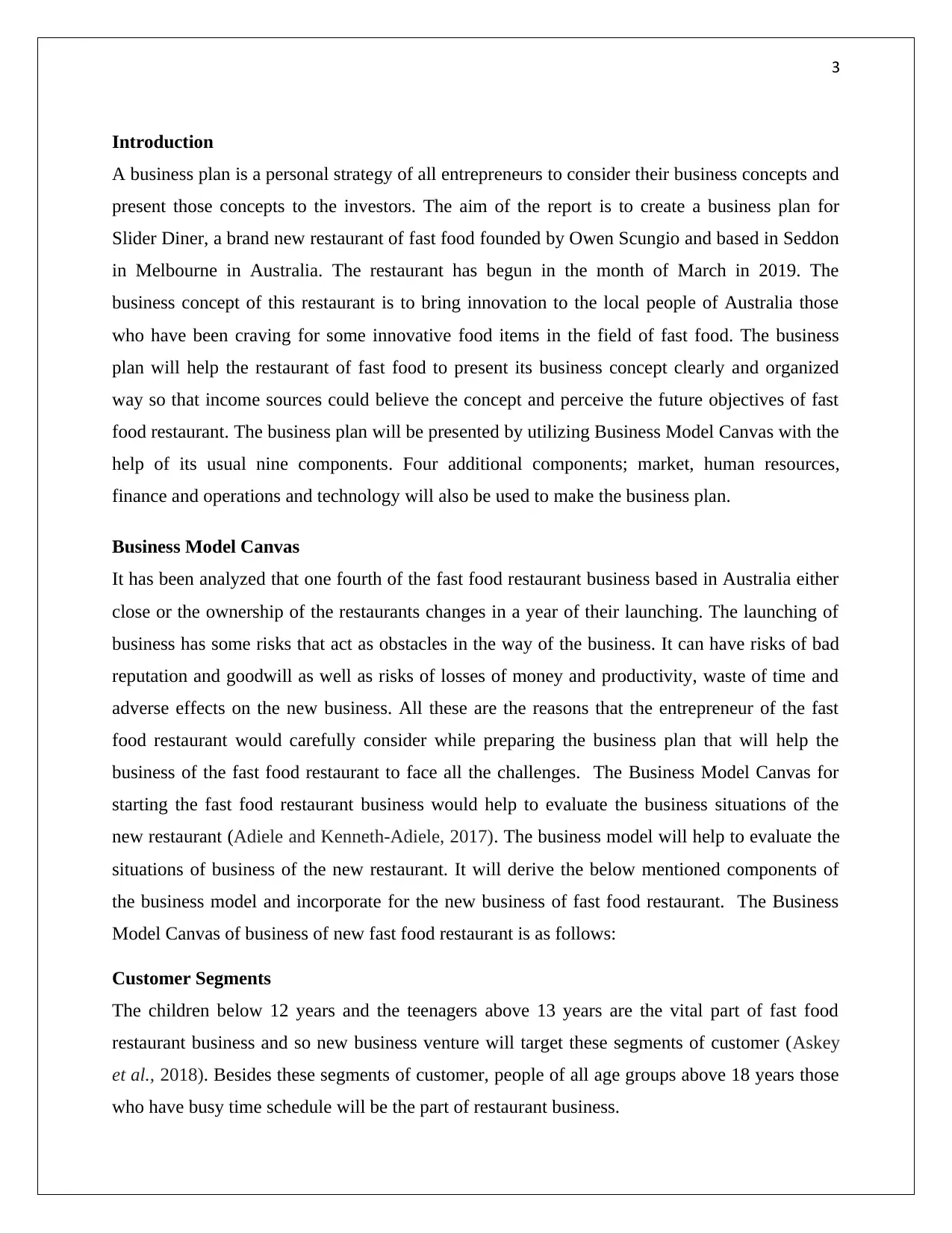
3
Introduction
A business plan is a personal strategy of all entrepreneurs to consider their business concepts and
present those concepts to the investors. The aim of the report is to create a business plan for
Slider Diner, a brand new restaurant of fast food founded by Owen Scungio and based in Seddon
in Melbourne in Australia. The restaurant has begun in the month of March in 2019. The
business concept of this restaurant is to bring innovation to the local people of Australia those
who have been craving for some innovative food items in the field of fast food. The business
plan will help the restaurant of fast food to present its business concept clearly and organized
way so that income sources could believe the concept and perceive the future objectives of fast
food restaurant. The business plan will be presented by utilizing Business Model Canvas with the
help of its usual nine components. Four additional components; market, human resources,
finance and operations and technology will also be used to make the business plan.
Business Model Canvas
It has been analyzed that one fourth of the fast food restaurant business based in Australia either
close or the ownership of the restaurants changes in a year of their launching. The launching of
business has some risks that act as obstacles in the way of the business. It can have risks of bad
reputation and goodwill as well as risks of losses of money and productivity, waste of time and
adverse effects on the new business. All these are the reasons that the entrepreneur of the fast
food restaurant would carefully consider while preparing the business plan that will help the
business of the fast food restaurant to face all the challenges. The Business Model Canvas for
starting the fast food restaurant business would help to evaluate the business situations of the
new restaurant (Adiele and Kenneth-Adiele, 2017). The business model will help to evaluate the
situations of business of the new restaurant. It will derive the below mentioned components of
the business model and incorporate for the new business of fast food restaurant. The Business
Model Canvas of business of new fast food restaurant is as follows:
Customer Segments
The children below 12 years and the teenagers above 13 years are the vital part of fast food
restaurant business and so new business venture will target these segments of customer (Askey
et al., 2018). Besides these segments of customer, people of all age groups above 18 years those
who have busy time schedule will be the part of restaurant business.
Introduction
A business plan is a personal strategy of all entrepreneurs to consider their business concepts and
present those concepts to the investors. The aim of the report is to create a business plan for
Slider Diner, a brand new restaurant of fast food founded by Owen Scungio and based in Seddon
in Melbourne in Australia. The restaurant has begun in the month of March in 2019. The
business concept of this restaurant is to bring innovation to the local people of Australia those
who have been craving for some innovative food items in the field of fast food. The business
plan will help the restaurant of fast food to present its business concept clearly and organized
way so that income sources could believe the concept and perceive the future objectives of fast
food restaurant. The business plan will be presented by utilizing Business Model Canvas with the
help of its usual nine components. Four additional components; market, human resources,
finance and operations and technology will also be used to make the business plan.
Business Model Canvas
It has been analyzed that one fourth of the fast food restaurant business based in Australia either
close or the ownership of the restaurants changes in a year of their launching. The launching of
business has some risks that act as obstacles in the way of the business. It can have risks of bad
reputation and goodwill as well as risks of losses of money and productivity, waste of time and
adverse effects on the new business. All these are the reasons that the entrepreneur of the fast
food restaurant would carefully consider while preparing the business plan that will help the
business of the fast food restaurant to face all the challenges. The Business Model Canvas for
starting the fast food restaurant business would help to evaluate the business situations of the
new restaurant (Adiele and Kenneth-Adiele, 2017). The business model will help to evaluate the
situations of business of the new restaurant. It will derive the below mentioned components of
the business model and incorporate for the new business of fast food restaurant. The Business
Model Canvas of business of new fast food restaurant is as follows:
Customer Segments
The children below 12 years and the teenagers above 13 years are the vital part of fast food
restaurant business and so new business venture will target these segments of customer (Askey
et al., 2018). Besides these segments of customer, people of all age groups above 18 years those
who have busy time schedule will be the part of restaurant business.
Secure Best Marks with AI Grader
Need help grading? Try our AI Grader for instant feedback on your assignments.
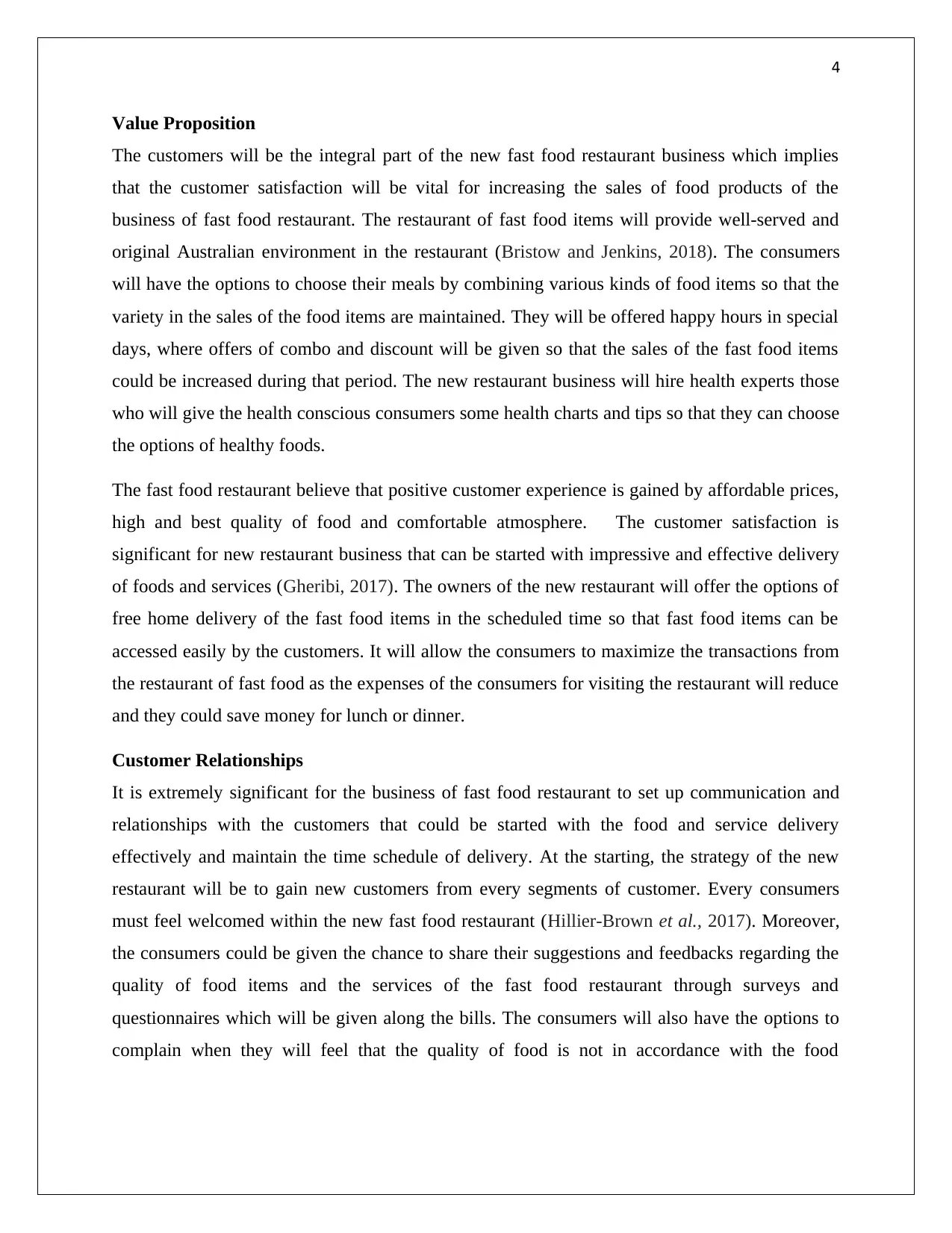
4
Value Proposition
The customers will be the integral part of the new fast food restaurant business which implies
that the customer satisfaction will be vital for increasing the sales of food products of the
business of fast food restaurant. The restaurant of fast food items will provide well-served and
original Australian environment in the restaurant (Bristow and Jenkins, 2018). The consumers
will have the options to choose their meals by combining various kinds of food items so that the
variety in the sales of the food items are maintained. They will be offered happy hours in special
days, where offers of combo and discount will be given so that the sales of the fast food items
could be increased during that period. The new restaurant business will hire health experts those
who will give the health conscious consumers some health charts and tips so that they can choose
the options of healthy foods.
The fast food restaurant believe that positive customer experience is gained by affordable prices,
high and best quality of food and comfortable atmosphere. The customer satisfaction is
significant for new restaurant business that can be started with impressive and effective delivery
of foods and services (Gheribi, 2017). The owners of the new restaurant will offer the options of
free home delivery of the fast food items in the scheduled time so that fast food items can be
accessed easily by the customers. It will allow the consumers to maximize the transactions from
the restaurant of fast food as the expenses of the consumers for visiting the restaurant will reduce
and they could save money for lunch or dinner.
Customer Relationships
It is extremely significant for the business of fast food restaurant to set up communication and
relationships with the customers that could be started with the food and service delivery
effectively and maintain the time schedule of delivery. At the starting, the strategy of the new
restaurant will be to gain new customers from every segments of customer. Every consumers
must feel welcomed within the new fast food restaurant (Hillier‐Brown et al., 2017). Moreover,
the consumers could be given the chance to share their suggestions and feedbacks regarding the
quality of food items and the services of the fast food restaurant through surveys and
questionnaires which will be given along the bills. The consumers will also have the options to
complain when they will feel that the quality of food is not in accordance with the food
Value Proposition
The customers will be the integral part of the new fast food restaurant business which implies
that the customer satisfaction will be vital for increasing the sales of food products of the
business of fast food restaurant. The restaurant of fast food items will provide well-served and
original Australian environment in the restaurant (Bristow and Jenkins, 2018). The consumers
will have the options to choose their meals by combining various kinds of food items so that the
variety in the sales of the food items are maintained. They will be offered happy hours in special
days, where offers of combo and discount will be given so that the sales of the fast food items
could be increased during that period. The new restaurant business will hire health experts those
who will give the health conscious consumers some health charts and tips so that they can choose
the options of healthy foods.
The fast food restaurant believe that positive customer experience is gained by affordable prices,
high and best quality of food and comfortable atmosphere. The customer satisfaction is
significant for new restaurant business that can be started with impressive and effective delivery
of foods and services (Gheribi, 2017). The owners of the new restaurant will offer the options of
free home delivery of the fast food items in the scheduled time so that fast food items can be
accessed easily by the customers. It will allow the consumers to maximize the transactions from
the restaurant of fast food as the expenses of the consumers for visiting the restaurant will reduce
and they could save money for lunch or dinner.
Customer Relationships
It is extremely significant for the business of fast food restaurant to set up communication and
relationships with the customers that could be started with the food and service delivery
effectively and maintain the time schedule of delivery. At the starting, the strategy of the new
restaurant will be to gain new customers from every segments of customer. Every consumers
must feel welcomed within the new fast food restaurant (Hillier‐Brown et al., 2017). Moreover,
the consumers could be given the chance to share their suggestions and feedbacks regarding the
quality of food items and the services of the fast food restaurant through surveys and
questionnaires which will be given along the bills. The consumers will also have the options to
complain when they will feel that the quality of food is not in accordance with the food
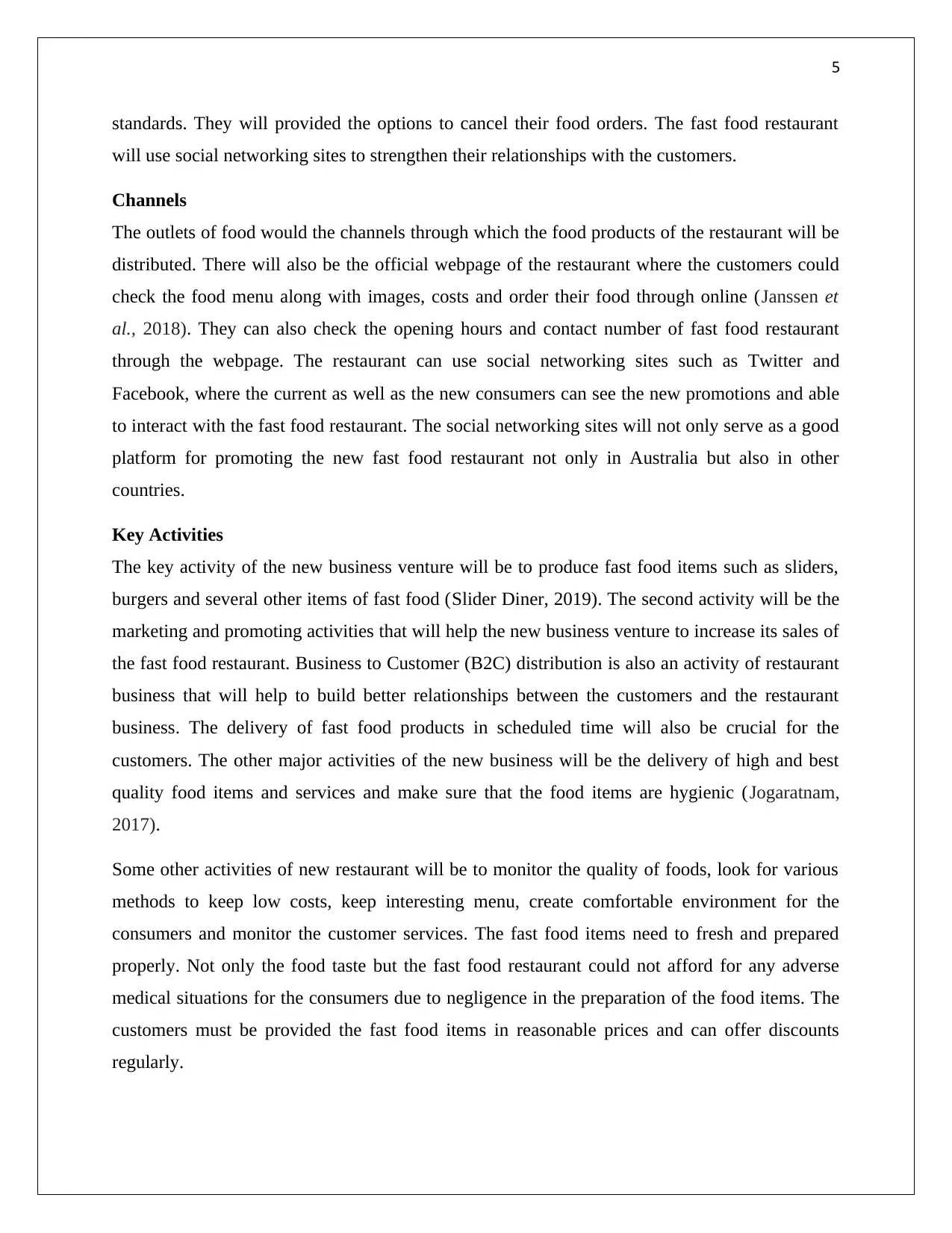
5
standards. They will provided the options to cancel their food orders. The fast food restaurant
will use social networking sites to strengthen their relationships with the customers.
Channels
The outlets of food would the channels through which the food products of the restaurant will be
distributed. There will also be the official webpage of the restaurant where the customers could
check the food menu along with images, costs and order their food through online (Janssen et
al., 2018). They can also check the opening hours and contact number of fast food restaurant
through the webpage. The restaurant can use social networking sites such as Twitter and
Facebook, where the current as well as the new consumers can see the new promotions and able
to interact with the fast food restaurant. The social networking sites will not only serve as a good
platform for promoting the new fast food restaurant not only in Australia but also in other
countries.
Key Activities
The key activity of the new business venture will be to produce fast food items such as sliders,
burgers and several other items of fast food (Slider Diner, 2019). The second activity will be the
marketing and promoting activities that will help the new business venture to increase its sales of
the fast food restaurant. Business to Customer (B2C) distribution is also an activity of restaurant
business that will help to build better relationships between the customers and the restaurant
business. The delivery of fast food products in scheduled time will also be crucial for the
customers. The other major activities of the new business will be the delivery of high and best
quality food items and services and make sure that the food items are hygienic (Jogaratnam,
2017).
Some other activities of new restaurant will be to monitor the quality of foods, look for various
methods to keep low costs, keep interesting menu, create comfortable environment for the
consumers and monitor the customer services. The fast food items need to fresh and prepared
properly. Not only the food taste but the fast food restaurant could not afford for any adverse
medical situations for the consumers due to negligence in the preparation of the food items. The
customers must be provided the fast food items in reasonable prices and can offer discounts
regularly.
standards. They will provided the options to cancel their food orders. The fast food restaurant
will use social networking sites to strengthen their relationships with the customers.
Channels
The outlets of food would the channels through which the food products of the restaurant will be
distributed. There will also be the official webpage of the restaurant where the customers could
check the food menu along with images, costs and order their food through online (Janssen et
al., 2018). They can also check the opening hours and contact number of fast food restaurant
through the webpage. The restaurant can use social networking sites such as Twitter and
Facebook, where the current as well as the new consumers can see the new promotions and able
to interact with the fast food restaurant. The social networking sites will not only serve as a good
platform for promoting the new fast food restaurant not only in Australia but also in other
countries.
Key Activities
The key activity of the new business venture will be to produce fast food items such as sliders,
burgers and several other items of fast food (Slider Diner, 2019). The second activity will be the
marketing and promoting activities that will help the new business venture to increase its sales of
the fast food restaurant. Business to Customer (B2C) distribution is also an activity of restaurant
business that will help to build better relationships between the customers and the restaurant
business. The delivery of fast food products in scheduled time will also be crucial for the
customers. The other major activities of the new business will be the delivery of high and best
quality food items and services and make sure that the food items are hygienic (Jogaratnam,
2017).
Some other activities of new restaurant will be to monitor the quality of foods, look for various
methods to keep low costs, keep interesting menu, create comfortable environment for the
consumers and monitor the customer services. The fast food items need to fresh and prepared
properly. Not only the food taste but the fast food restaurant could not afford for any adverse
medical situations for the consumers due to negligence in the preparation of the food items. The
customers must be provided the fast food items in reasonable prices and can offer discounts
regularly.
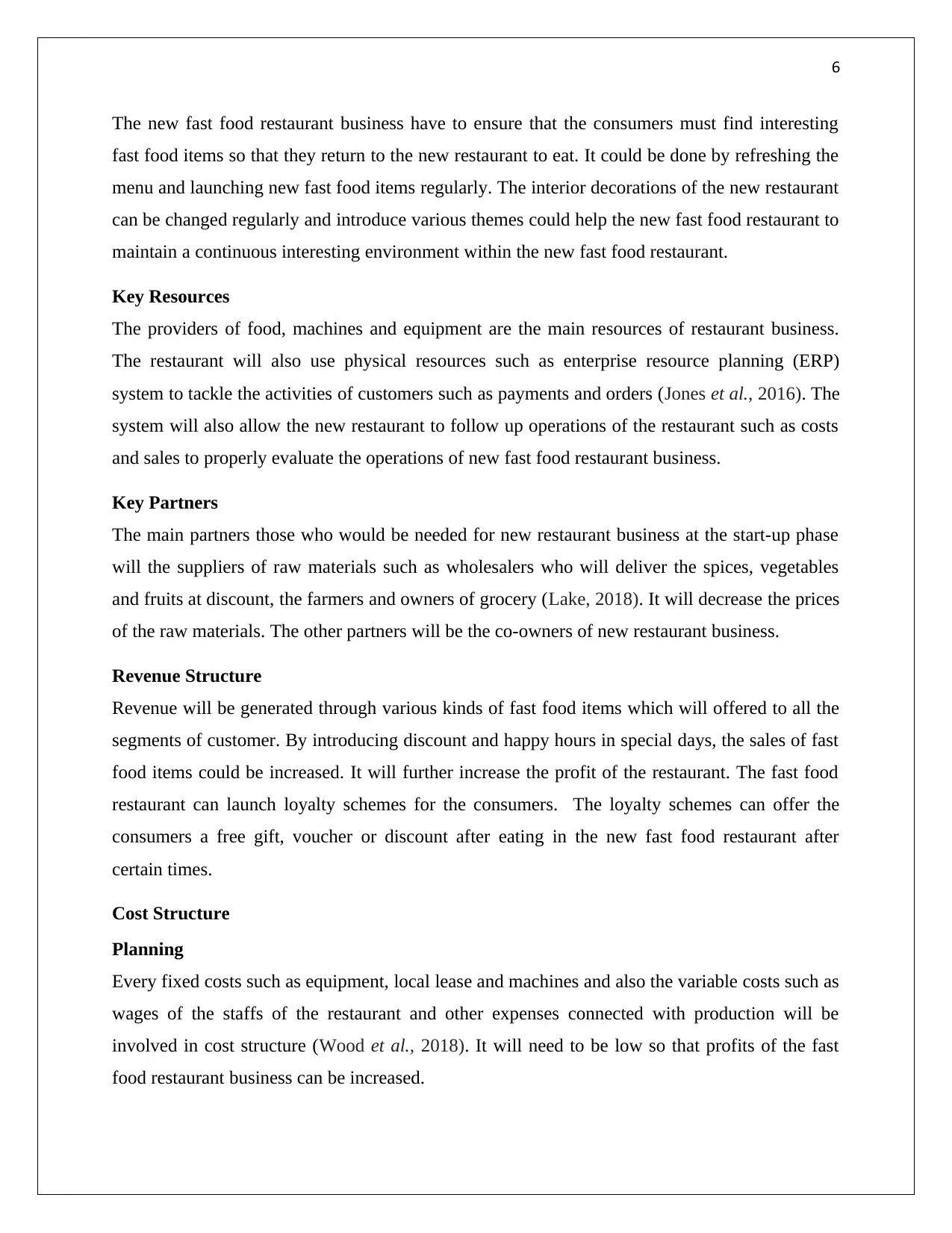
6
The new fast food restaurant business have to ensure that the consumers must find interesting
fast food items so that they return to the new restaurant to eat. It could be done by refreshing the
menu and launching new fast food items regularly. The interior decorations of the new restaurant
can be changed regularly and introduce various themes could help the new fast food restaurant to
maintain a continuous interesting environment within the new fast food restaurant.
Key Resources
The providers of food, machines and equipment are the main resources of restaurant business.
The restaurant will also use physical resources such as enterprise resource planning (ERP)
system to tackle the activities of customers such as payments and orders (Jones et al., 2016). The
system will also allow the new restaurant to follow up operations of the restaurant such as costs
and sales to properly evaluate the operations of new fast food restaurant business.
Key Partners
The main partners those who would be needed for new restaurant business at the start-up phase
will the suppliers of raw materials such as wholesalers who will deliver the spices, vegetables
and fruits at discount, the farmers and owners of grocery (Lake, 2018). It will decrease the prices
of the raw materials. The other partners will be the co-owners of new restaurant business.
Revenue Structure
Revenue will be generated through various kinds of fast food items which will offered to all the
segments of customer. By introducing discount and happy hours in special days, the sales of fast
food items could be increased. It will further increase the profit of the restaurant. The fast food
restaurant can launch loyalty schemes for the consumers. The loyalty schemes can offer the
consumers a free gift, voucher or discount after eating in the new fast food restaurant after
certain times.
Cost Structure
Planning
Every fixed costs such as equipment, local lease and machines and also the variable costs such as
wages of the staffs of the restaurant and other expenses connected with production will be
involved in cost structure (Wood et al., 2018). It will need to be low so that profits of the fast
food restaurant business can be increased.
The new fast food restaurant business have to ensure that the consumers must find interesting
fast food items so that they return to the new restaurant to eat. It could be done by refreshing the
menu and launching new fast food items regularly. The interior decorations of the new restaurant
can be changed regularly and introduce various themes could help the new fast food restaurant to
maintain a continuous interesting environment within the new fast food restaurant.
Key Resources
The providers of food, machines and equipment are the main resources of restaurant business.
The restaurant will also use physical resources such as enterprise resource planning (ERP)
system to tackle the activities of customers such as payments and orders (Jones et al., 2016). The
system will also allow the new restaurant to follow up operations of the restaurant such as costs
and sales to properly evaluate the operations of new fast food restaurant business.
Key Partners
The main partners those who would be needed for new restaurant business at the start-up phase
will the suppliers of raw materials such as wholesalers who will deliver the spices, vegetables
and fruits at discount, the farmers and owners of grocery (Lake, 2018). It will decrease the prices
of the raw materials. The other partners will be the co-owners of new restaurant business.
Revenue Structure
Revenue will be generated through various kinds of fast food items which will offered to all the
segments of customer. By introducing discount and happy hours in special days, the sales of fast
food items could be increased. It will further increase the profit of the restaurant. The fast food
restaurant can launch loyalty schemes for the consumers. The loyalty schemes can offer the
consumers a free gift, voucher or discount after eating in the new fast food restaurant after
certain times.
Cost Structure
Planning
Every fixed costs such as equipment, local lease and machines and also the variable costs such as
wages of the staffs of the restaurant and other expenses connected with production will be
involved in cost structure (Wood et al., 2018). It will need to be low so that profits of the fast
food restaurant business can be increased.
Paraphrase This Document
Need a fresh take? Get an instant paraphrase of this document with our AI Paraphraser
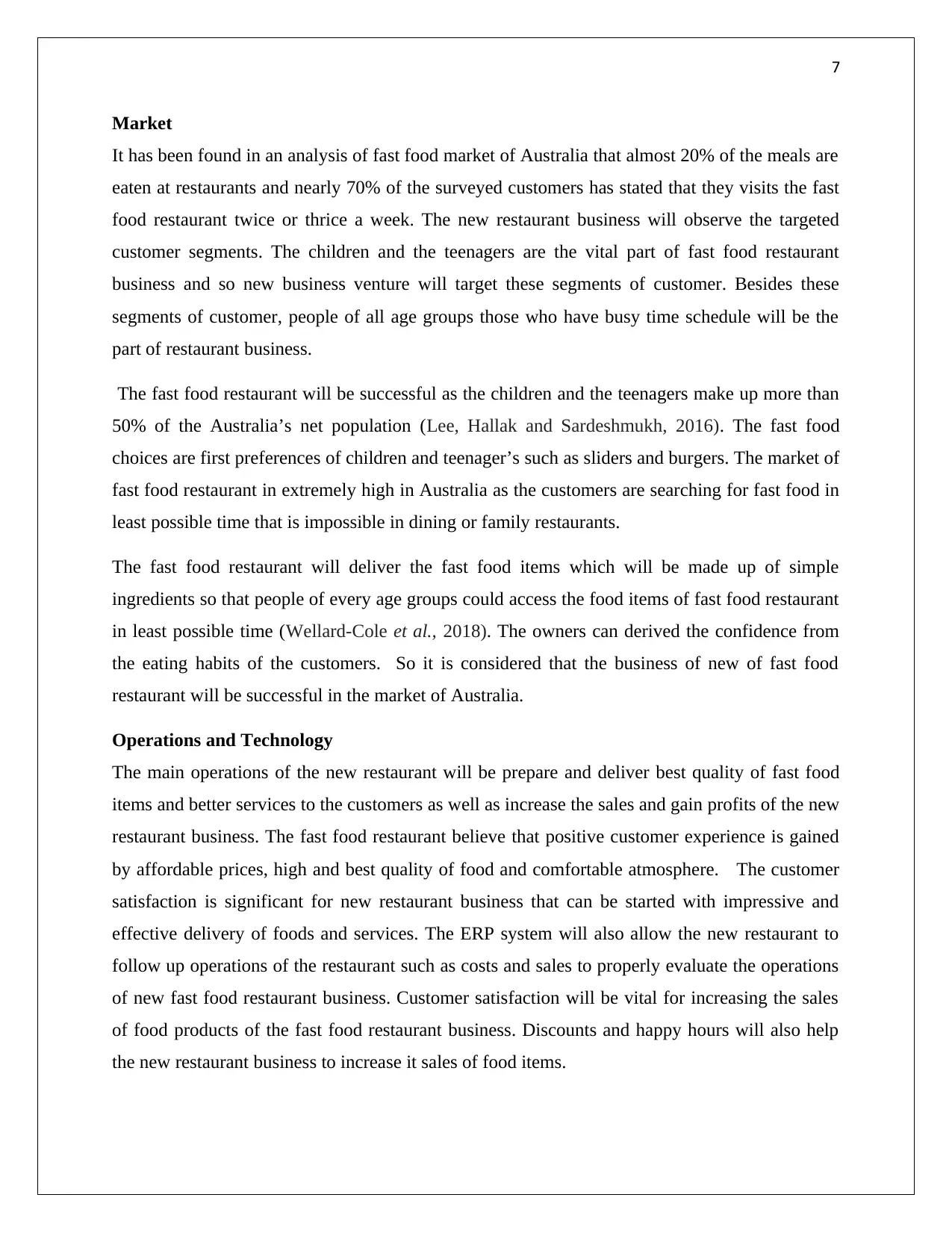
7
Market
It has been found in an analysis of fast food market of Australia that almost 20% of the meals are
eaten at restaurants and nearly 70% of the surveyed customers has stated that they visits the fast
food restaurant twice or thrice a week. The new restaurant business will observe the targeted
customer segments. The children and the teenagers are the vital part of fast food restaurant
business and so new business venture will target these segments of customer. Besides these
segments of customer, people of all age groups those who have busy time schedule will be the
part of restaurant business.
The fast food restaurant will be successful as the children and the teenagers make up more than
50% of the Australia’s net population (Lee, Hallak and Sardeshmukh, 2016). The fast food
choices are first preferences of children and teenager’s such as sliders and burgers. The market of
fast food restaurant in extremely high in Australia as the customers are searching for fast food in
least possible time that is impossible in dining or family restaurants.
The fast food restaurant will deliver the fast food items which will be made up of simple
ingredients so that people of every age groups could access the food items of fast food restaurant
in least possible time (Wellard-Cole et al., 2018). The owners can derived the confidence from
the eating habits of the customers. So it is considered that the business of new of fast food
restaurant will be successful in the market of Australia.
Operations and Technology
The main operations of the new restaurant will be prepare and deliver best quality of fast food
items and better services to the customers as well as increase the sales and gain profits of the new
restaurant business. The fast food restaurant believe that positive customer experience is gained
by affordable prices, high and best quality of food and comfortable atmosphere. The customer
satisfaction is significant for new restaurant business that can be started with impressive and
effective delivery of foods and services. The ERP system will also allow the new restaurant to
follow up operations of the restaurant such as costs and sales to properly evaluate the operations
of new fast food restaurant business. Customer satisfaction will be vital for increasing the sales
of food products of the fast food restaurant business. Discounts and happy hours will also help
the new restaurant business to increase it sales of food items.
Market
It has been found in an analysis of fast food market of Australia that almost 20% of the meals are
eaten at restaurants and nearly 70% of the surveyed customers has stated that they visits the fast
food restaurant twice or thrice a week. The new restaurant business will observe the targeted
customer segments. The children and the teenagers are the vital part of fast food restaurant
business and so new business venture will target these segments of customer. Besides these
segments of customer, people of all age groups those who have busy time schedule will be the
part of restaurant business.
The fast food restaurant will be successful as the children and the teenagers make up more than
50% of the Australia’s net population (Lee, Hallak and Sardeshmukh, 2016). The fast food
choices are first preferences of children and teenager’s such as sliders and burgers. The market of
fast food restaurant in extremely high in Australia as the customers are searching for fast food in
least possible time that is impossible in dining or family restaurants.
The fast food restaurant will deliver the fast food items which will be made up of simple
ingredients so that people of every age groups could access the food items of fast food restaurant
in least possible time (Wellard-Cole et al., 2018). The owners can derived the confidence from
the eating habits of the customers. So it is considered that the business of new of fast food
restaurant will be successful in the market of Australia.
Operations and Technology
The main operations of the new restaurant will be prepare and deliver best quality of fast food
items and better services to the customers as well as increase the sales and gain profits of the new
restaurant business. The fast food restaurant believe that positive customer experience is gained
by affordable prices, high and best quality of food and comfortable atmosphere. The customer
satisfaction is significant for new restaurant business that can be started with impressive and
effective delivery of foods and services. The ERP system will also allow the new restaurant to
follow up operations of the restaurant such as costs and sales to properly evaluate the operations
of new fast food restaurant business. Customer satisfaction will be vital for increasing the sales
of food products of the fast food restaurant business. Discounts and happy hours will also help
the new restaurant business to increase it sales of food items.
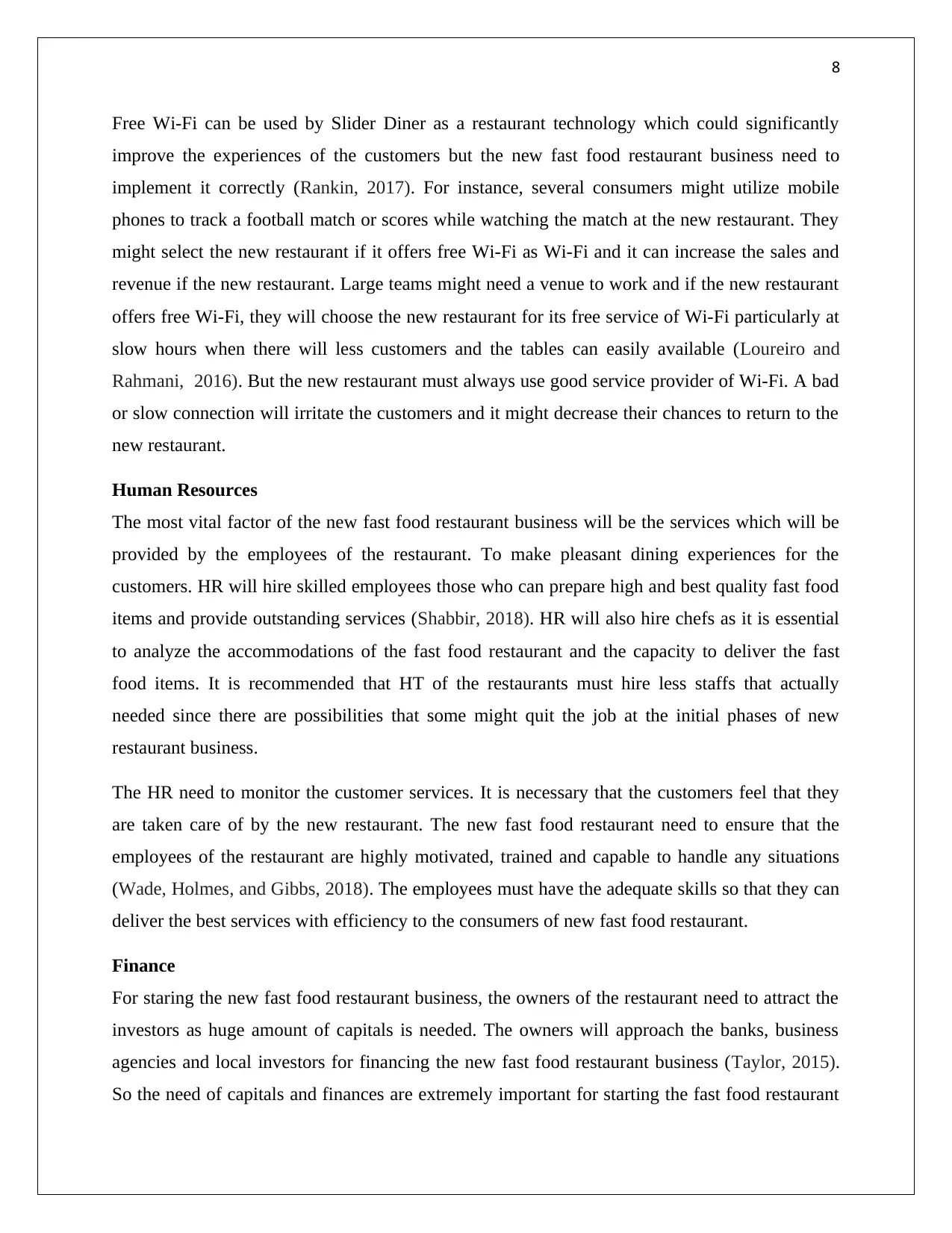
8
Free Wi-Fi can be used by Slider Diner as a restaurant technology which could significantly
improve the experiences of the customers but the new fast food restaurant business need to
implement it correctly (Rankin, 2017). For instance, several consumers might utilize mobile
phones to track a football match or scores while watching the match at the new restaurant. They
might select the new restaurant if it offers free Wi-Fi as Wi-Fi and it can increase the sales and
revenue if the new restaurant. Large teams might need a venue to work and if the new restaurant
offers free Wi-Fi, they will choose the new restaurant for its free service of Wi-Fi particularly at
slow hours when there will less customers and the tables can easily available (Loureiro and
Rahmani, 2016). But the new restaurant must always use good service provider of Wi-Fi. A bad
or slow connection will irritate the customers and it might decrease their chances to return to the
new restaurant.
Human Resources
The most vital factor of the new fast food restaurant business will be the services which will be
provided by the employees of the restaurant. To make pleasant dining experiences for the
customers. HR will hire skilled employees those who can prepare high and best quality fast food
items and provide outstanding services (Shabbir, 2018). HR will also hire chefs as it is essential
to analyze the accommodations of the fast food restaurant and the capacity to deliver the fast
food items. It is recommended that HT of the restaurants must hire less staffs that actually
needed since there are possibilities that some might quit the job at the initial phases of new
restaurant business.
The HR need to monitor the customer services. It is necessary that the customers feel that they
are taken care of by the new restaurant. The new fast food restaurant need to ensure that the
employees of the restaurant are highly motivated, trained and capable to handle any situations
(Wade, Holmes, and Gibbs, 2018). The employees must have the adequate skills so that they can
deliver the best services with efficiency to the consumers of new fast food restaurant.
Finance
For staring the new fast food restaurant business, the owners of the restaurant need to attract the
investors as huge amount of capitals is needed. The owners will approach the banks, business
agencies and local investors for financing the new fast food restaurant business (Taylor, 2015).
So the need of capitals and finances are extremely important for starting the fast food restaurant
Free Wi-Fi can be used by Slider Diner as a restaurant technology which could significantly
improve the experiences of the customers but the new fast food restaurant business need to
implement it correctly (Rankin, 2017). For instance, several consumers might utilize mobile
phones to track a football match or scores while watching the match at the new restaurant. They
might select the new restaurant if it offers free Wi-Fi as Wi-Fi and it can increase the sales and
revenue if the new restaurant. Large teams might need a venue to work and if the new restaurant
offers free Wi-Fi, they will choose the new restaurant for its free service of Wi-Fi particularly at
slow hours when there will less customers and the tables can easily available (Loureiro and
Rahmani, 2016). But the new restaurant must always use good service provider of Wi-Fi. A bad
or slow connection will irritate the customers and it might decrease their chances to return to the
new restaurant.
Human Resources
The most vital factor of the new fast food restaurant business will be the services which will be
provided by the employees of the restaurant. To make pleasant dining experiences for the
customers. HR will hire skilled employees those who can prepare high and best quality fast food
items and provide outstanding services (Shabbir, 2018). HR will also hire chefs as it is essential
to analyze the accommodations of the fast food restaurant and the capacity to deliver the fast
food items. It is recommended that HT of the restaurants must hire less staffs that actually
needed since there are possibilities that some might quit the job at the initial phases of new
restaurant business.
The HR need to monitor the customer services. It is necessary that the customers feel that they
are taken care of by the new restaurant. The new fast food restaurant need to ensure that the
employees of the restaurant are highly motivated, trained and capable to handle any situations
(Wade, Holmes, and Gibbs, 2018). The employees must have the adequate skills so that they can
deliver the best services with efficiency to the consumers of new fast food restaurant.
Finance
For staring the new fast food restaurant business, the owners of the restaurant need to attract the
investors as huge amount of capitals is needed. The owners will approach the banks, business
agencies and local investors for financing the new fast food restaurant business (Taylor, 2015).
So the need of capitals and finances are extremely important for starting the fast food restaurant
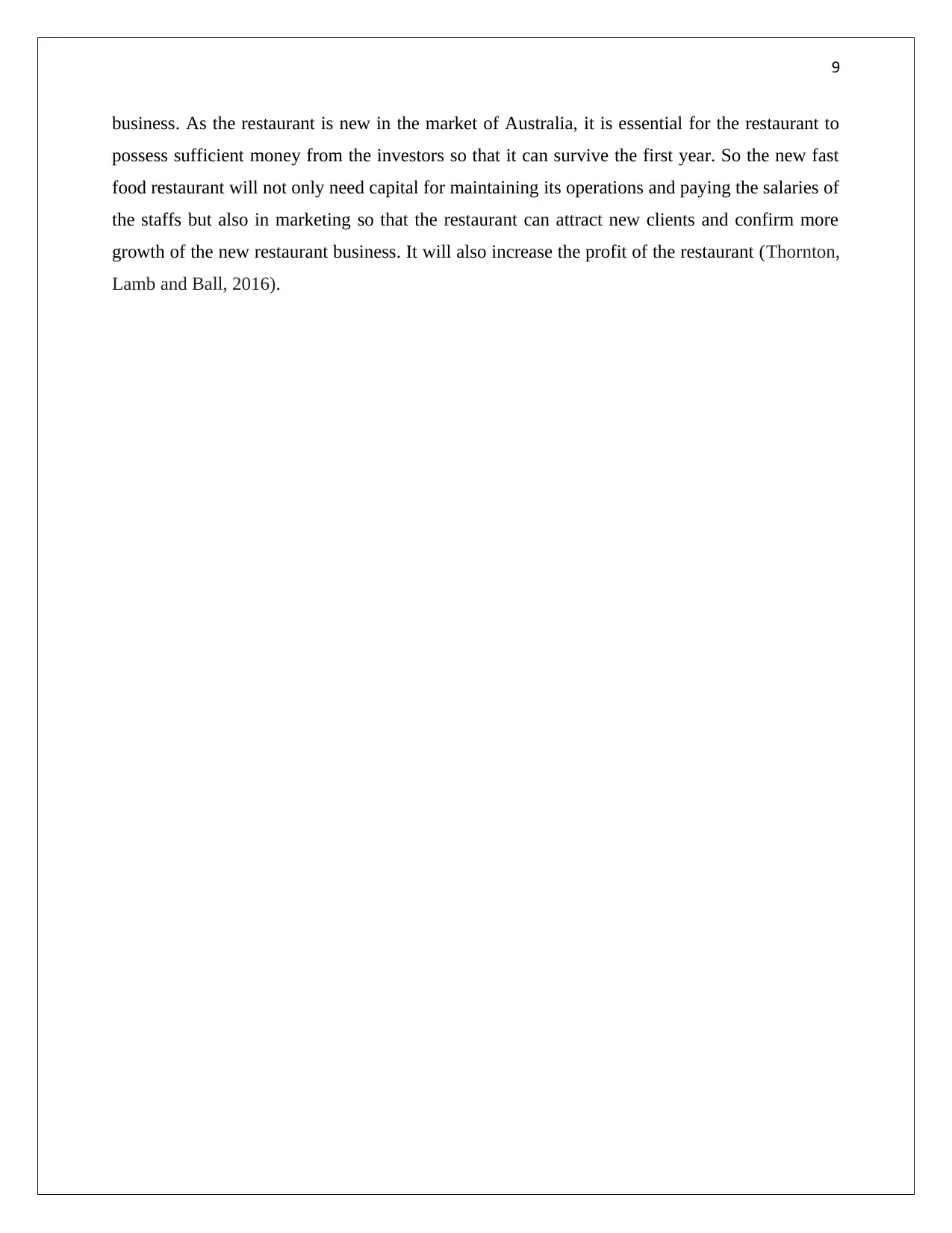
9
business. As the restaurant is new in the market of Australia, it is essential for the restaurant to
possess sufficient money from the investors so that it can survive the first year. So the new fast
food restaurant will not only need capital for maintaining its operations and paying the salaries of
the staffs but also in marketing so that the restaurant can attract new clients and confirm more
growth of the new restaurant business. It will also increase the profit of the restaurant (Thornton,
Lamb and Ball, 2016).
business. As the restaurant is new in the market of Australia, it is essential for the restaurant to
possess sufficient money from the investors so that it can survive the first year. So the new fast
food restaurant will not only need capital for maintaining its operations and paying the salaries of
the staffs but also in marketing so that the restaurant can attract new clients and confirm more
growth of the new restaurant business. It will also increase the profit of the restaurant (Thornton,
Lamb and Ball, 2016).
Secure Best Marks with AI Grader
Need help grading? Try our AI Grader for instant feedback on your assignments.
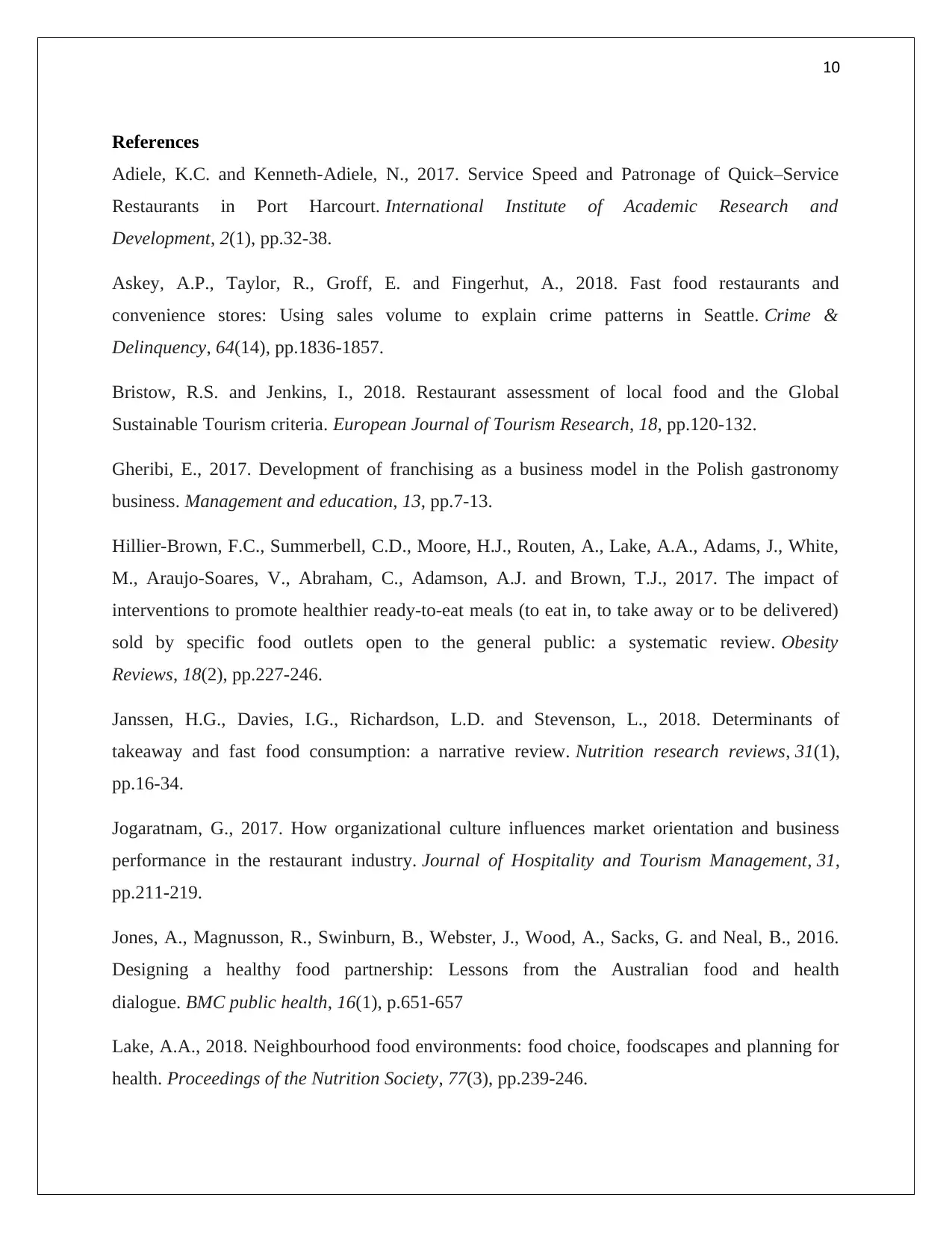
10
References
Adiele, K.C. and Kenneth-Adiele, N., 2017. Service Speed and Patronage of Quick–Service
Restaurants in Port Harcourt. International Institute of Academic Research and
Development, 2(1), pp.32-38.
Askey, A.P., Taylor, R., Groff, E. and Fingerhut, A., 2018. Fast food restaurants and
convenience stores: Using sales volume to explain crime patterns in Seattle. Crime &
Delinquency, 64(14), pp.1836-1857.
Bristow, R.S. and Jenkins, I., 2018. Restaurant assessment of local food and the Global
Sustainable Tourism criteria. European Journal of Tourism Research, 18, pp.120-132.
Gheribi, E., 2017. Development of franchising as a business model in the Polish gastronomy
business. Management and education, 13, pp.7-13.
Hillier‐Brown, F.C., Summerbell, C.D., Moore, H.J., Routen, A., Lake, A.A., Adams, J., White,
M., Araujo‐Soares, V., Abraham, C., Adamson, A.J. and Brown, T.J., 2017. The impact of
interventions to promote healthier ready‐to‐eat meals (to eat in, to take away or to be delivered)
sold by specific food outlets open to the general public: a systematic review. Obesity
Reviews, 18(2), pp.227-246.
Janssen, H.G., Davies, I.G., Richardson, L.D. and Stevenson, L., 2018. Determinants of
takeaway and fast food consumption: a narrative review. Nutrition research reviews, 31(1),
pp.16-34.
Jogaratnam, G., 2017. How organizational culture influences market orientation and business
performance in the restaurant industry. Journal of Hospitality and Tourism Management, 31,
pp.211-219.
Jones, A., Magnusson, R., Swinburn, B., Webster, J., Wood, A., Sacks, G. and Neal, B., 2016.
Designing a healthy food partnership: Lessons from the Australian food and health
dialogue. BMC public health, 16(1), p.651-657
Lake, A.A., 2018. Neighbourhood food environments: food choice, foodscapes and planning for
health. Proceedings of the Nutrition Society, 77(3), pp.239-246.
References
Adiele, K.C. and Kenneth-Adiele, N., 2017. Service Speed and Patronage of Quick–Service
Restaurants in Port Harcourt. International Institute of Academic Research and
Development, 2(1), pp.32-38.
Askey, A.P., Taylor, R., Groff, E. and Fingerhut, A., 2018. Fast food restaurants and
convenience stores: Using sales volume to explain crime patterns in Seattle. Crime &
Delinquency, 64(14), pp.1836-1857.
Bristow, R.S. and Jenkins, I., 2018. Restaurant assessment of local food and the Global
Sustainable Tourism criteria. European Journal of Tourism Research, 18, pp.120-132.
Gheribi, E., 2017. Development of franchising as a business model in the Polish gastronomy
business. Management and education, 13, pp.7-13.
Hillier‐Brown, F.C., Summerbell, C.D., Moore, H.J., Routen, A., Lake, A.A., Adams, J., White,
M., Araujo‐Soares, V., Abraham, C., Adamson, A.J. and Brown, T.J., 2017. The impact of
interventions to promote healthier ready‐to‐eat meals (to eat in, to take away or to be delivered)
sold by specific food outlets open to the general public: a systematic review. Obesity
Reviews, 18(2), pp.227-246.
Janssen, H.G., Davies, I.G., Richardson, L.D. and Stevenson, L., 2018. Determinants of
takeaway and fast food consumption: a narrative review. Nutrition research reviews, 31(1),
pp.16-34.
Jogaratnam, G., 2017. How organizational culture influences market orientation and business
performance in the restaurant industry. Journal of Hospitality and Tourism Management, 31,
pp.211-219.
Jones, A., Magnusson, R., Swinburn, B., Webster, J., Wood, A., Sacks, G. and Neal, B., 2016.
Designing a healthy food partnership: Lessons from the Australian food and health
dialogue. BMC public health, 16(1), p.651-657
Lake, A.A., 2018. Neighbourhood food environments: food choice, foodscapes and planning for
health. Proceedings of the Nutrition Society, 77(3), pp.239-246.
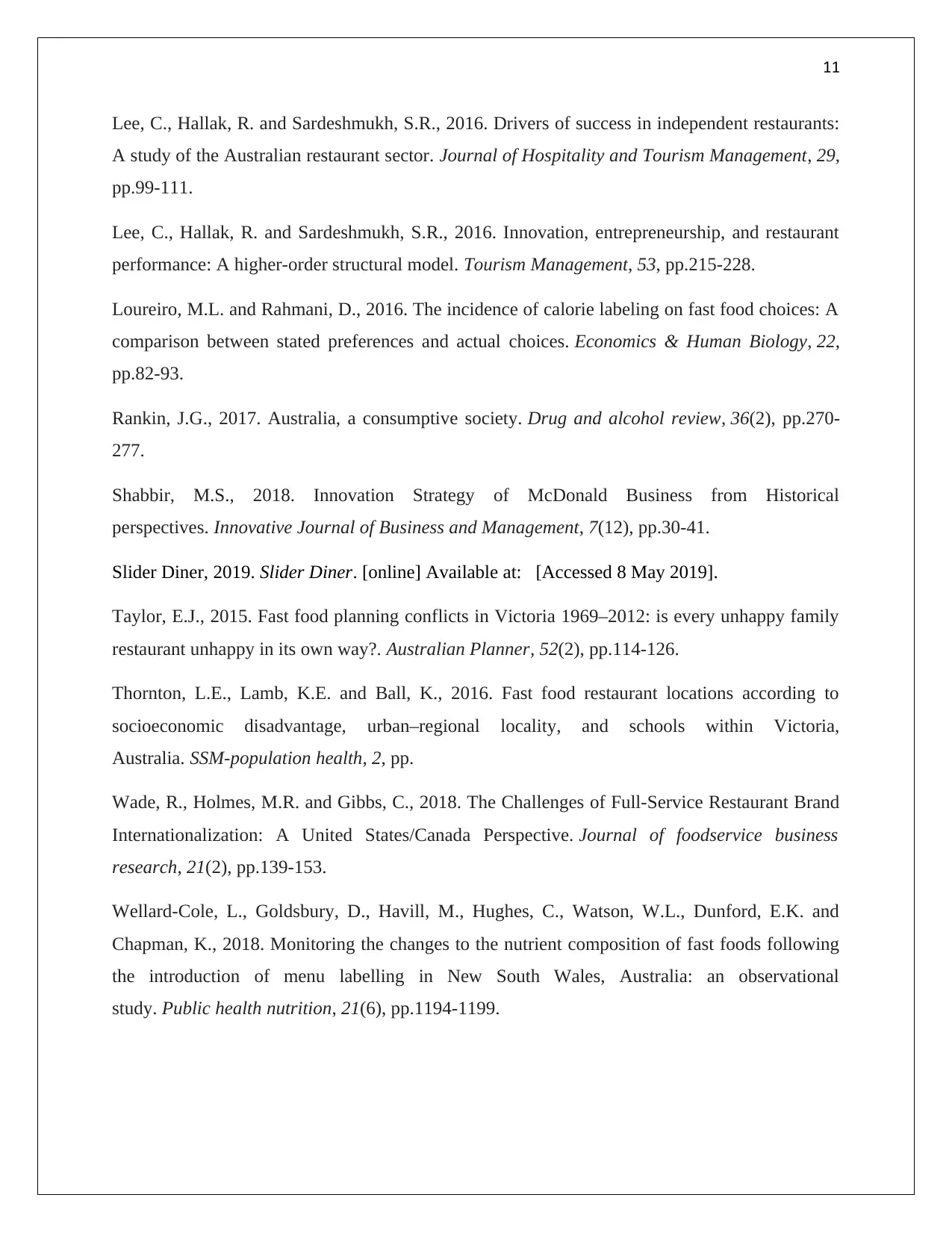
11
Lee, C., Hallak, R. and Sardeshmukh, S.R., 2016. Drivers of success in independent restaurants:
A study of the Australian restaurant sector. Journal of Hospitality and Tourism Management, 29,
pp.99-111.
Lee, C., Hallak, R. and Sardeshmukh, S.R., 2016. Innovation, entrepreneurship, and restaurant
performance: A higher-order structural model. Tourism Management, 53, pp.215-228.
Loureiro, M.L. and Rahmani, D., 2016. The incidence of calorie labeling on fast food choices: A
comparison between stated preferences and actual choices. Economics & Human Biology, 22,
pp.82-93.
Rankin, J.G., 2017. Australia, a consumptive society. Drug and alcohol review, 36(2), pp.270-
277.
Shabbir, M.S., 2018. Innovation Strategy of McDonald Business from Historical
perspectives. Innovative Journal of Business and Management, 7(12), pp.30-41.
Slider Diner, 2019. Slider Diner. [online] Available at: [Accessed 8 May 2019].
Taylor, E.J., 2015. Fast food planning conflicts in Victoria 1969–2012: is every unhappy family
restaurant unhappy in its own way?. Australian Planner, 52(2), pp.114-126.
Thornton, L.E., Lamb, K.E. and Ball, K., 2016. Fast food restaurant locations according to
socioeconomic disadvantage, urban–regional locality, and schools within Victoria,
Australia. SSM-population health, 2, pp.
Wade, R., Holmes, M.R. and Gibbs, C., 2018. The Challenges of Full-Service Restaurant Brand
Internationalization: A United States/Canada Perspective. Journal of foodservice business
research, 21(2), pp.139-153.
Wellard-Cole, L., Goldsbury, D., Havill, M., Hughes, C., Watson, W.L., Dunford, E.K. and
Chapman, K., 2018. Monitoring the changes to the nutrient composition of fast foods following
the introduction of menu labelling in New South Wales, Australia: an observational
study. Public health nutrition, 21(6), pp.1194-1199.
Lee, C., Hallak, R. and Sardeshmukh, S.R., 2016. Drivers of success in independent restaurants:
A study of the Australian restaurant sector. Journal of Hospitality and Tourism Management, 29,
pp.99-111.
Lee, C., Hallak, R. and Sardeshmukh, S.R., 2016. Innovation, entrepreneurship, and restaurant
performance: A higher-order structural model. Tourism Management, 53, pp.215-228.
Loureiro, M.L. and Rahmani, D., 2016. The incidence of calorie labeling on fast food choices: A
comparison between stated preferences and actual choices. Economics & Human Biology, 22,
pp.82-93.
Rankin, J.G., 2017. Australia, a consumptive society. Drug and alcohol review, 36(2), pp.270-
277.
Shabbir, M.S., 2018. Innovation Strategy of McDonald Business from Historical
perspectives. Innovative Journal of Business and Management, 7(12), pp.30-41.
Slider Diner, 2019. Slider Diner. [online] Available at: [Accessed 8 May 2019].
Taylor, E.J., 2015. Fast food planning conflicts in Victoria 1969–2012: is every unhappy family
restaurant unhappy in its own way?. Australian Planner, 52(2), pp.114-126.
Thornton, L.E., Lamb, K.E. and Ball, K., 2016. Fast food restaurant locations according to
socioeconomic disadvantage, urban–regional locality, and schools within Victoria,
Australia. SSM-population health, 2, pp.
Wade, R., Holmes, M.R. and Gibbs, C., 2018. The Challenges of Full-Service Restaurant Brand
Internationalization: A United States/Canada Perspective. Journal of foodservice business
research, 21(2), pp.139-153.
Wellard-Cole, L., Goldsbury, D., Havill, M., Hughes, C., Watson, W.L., Dunford, E.K. and
Chapman, K., 2018. Monitoring the changes to the nutrient composition of fast foods following
the introduction of menu labelling in New South Wales, Australia: an observational
study. Public health nutrition, 21(6), pp.1194-1199.

12
Wood, L., Snelgrove, R., Legg, J., Taks, M. and Potwarka, L.R., 2018. Perspectives of event
leveraging by restaurants and city officials. International Journal of Event and Festival
Management, 9(1), pp.34-50.
Wood, L., Snelgrove, R., Legg, J., Taks, M. and Potwarka, L.R., 2018. Perspectives of event
leveraging by restaurants and city officials. International Journal of Event and Festival
Management, 9(1), pp.34-50.
Paraphrase This Document
Need a fresh take? Get an instant paraphrase of this document with our AI Paraphraser
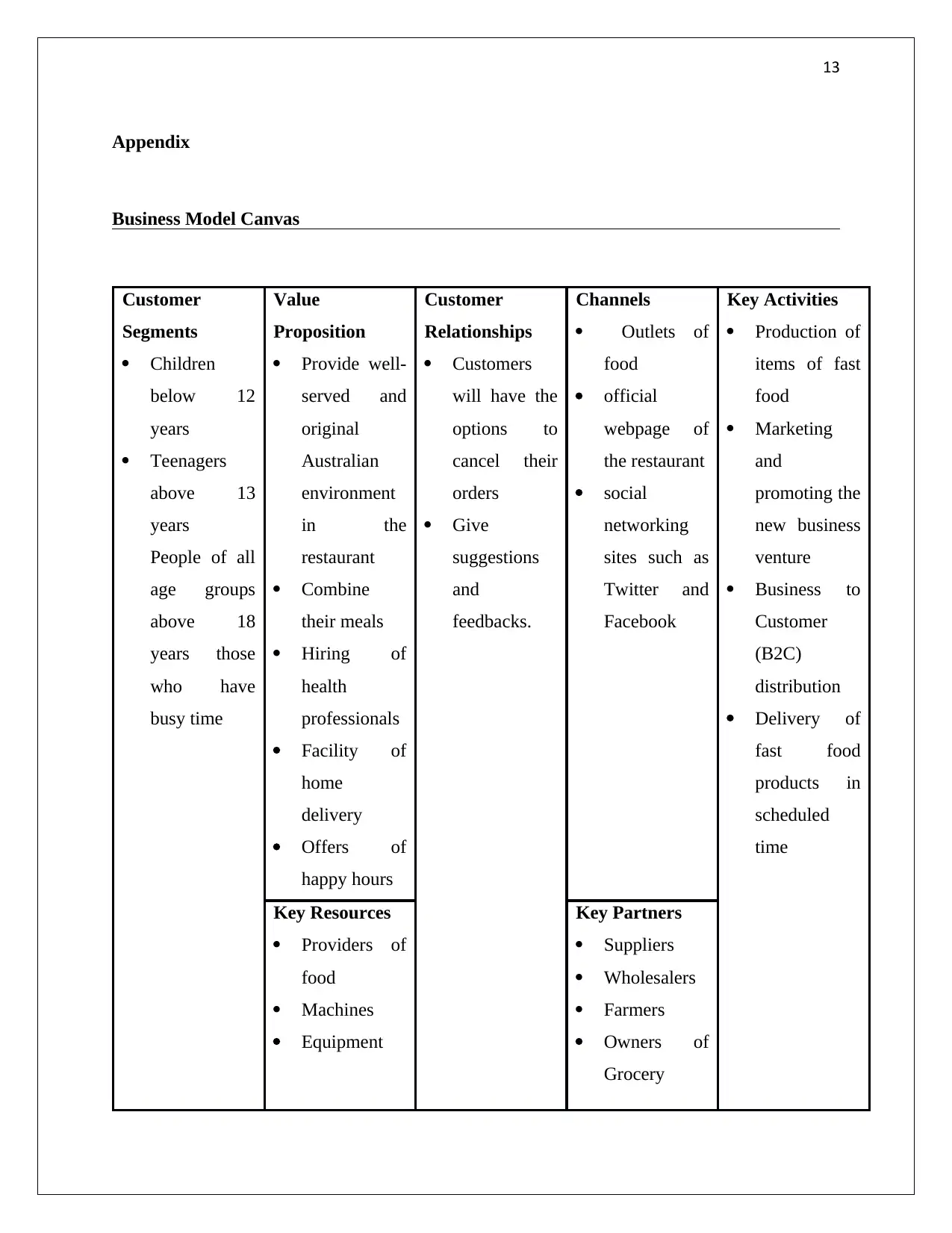
13
Appendix
Business Model Canvas
Customer
Segments
Children
below 12
years
Teenagers
above 13
years
People of all
age groups
above 18
years those
who have
busy time
Value
Proposition
Provide well-
served and
original
Australian
environment
in the
restaurant
Combine
their meals
Hiring of
health
professionals
Facility of
home
delivery
Offers of
happy hours
Customer
Relationships
Customers
will have the
options to
cancel their
orders
Give
suggestions
and
feedbacks.
Channels
Outlets of
food
official
webpage of
the restaurant
social
networking
sites such as
Twitter and
Facebook
Key Activities
Production of
items of fast
food
Marketing
and
promoting the
new business
venture
Business to
Customer
(B2C)
distribution
Delivery of
fast food
products in
scheduled
time
Key Resources
Providers of
food
Machines
Equipment
Key Partners
Suppliers
Wholesalers
Farmers
Owners of
Grocery
Appendix
Business Model Canvas
Customer
Segments
Children
below 12
years
Teenagers
above 13
years
People of all
age groups
above 18
years those
who have
busy time
Value
Proposition
Provide well-
served and
original
Australian
environment
in the
restaurant
Combine
their meals
Hiring of
health
professionals
Facility of
home
delivery
Offers of
happy hours
Customer
Relationships
Customers
will have the
options to
cancel their
orders
Give
suggestions
and
feedbacks.
Channels
Outlets of
food
official
webpage of
the restaurant
social
networking
sites such as
Twitter and
Key Activities
Production of
items of fast
food
Marketing
and
promoting the
new business
venture
Business to
Customer
(B2C)
distribution
Delivery of
fast food
products in
scheduled
time
Key Resources
Providers of
food
Machines
Equipment
Key Partners
Suppliers
Wholesalers
Farmers
Owners of
Grocery
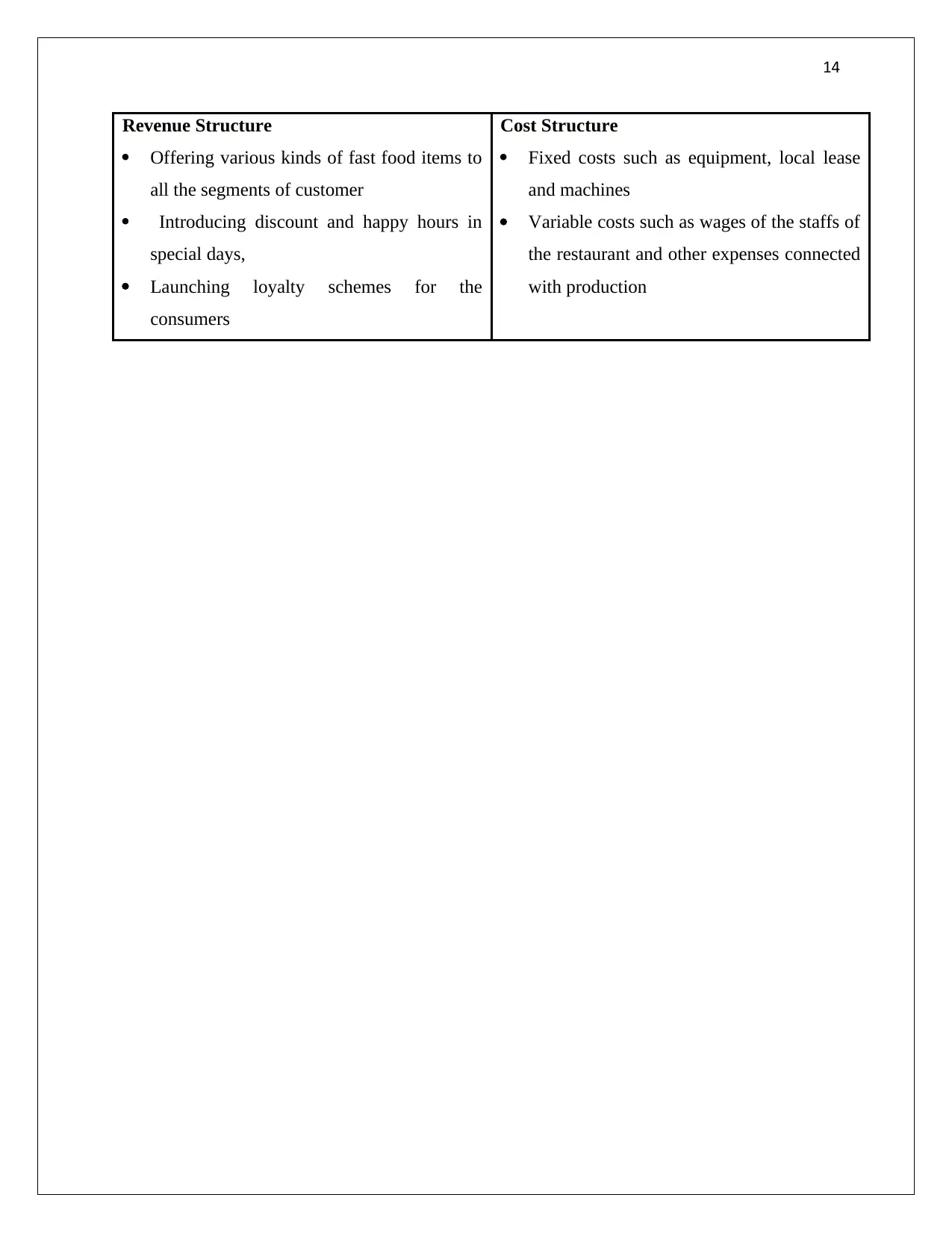
14
Revenue Structure
Offering various kinds of fast food items to
all the segments of customer
Introducing discount and happy hours in
special days,
Launching loyalty schemes for the
consumers
Cost Structure
Fixed costs such as equipment, local lease
and machines
Variable costs such as wages of the staffs of
the restaurant and other expenses connected
with production
Revenue Structure
Offering various kinds of fast food items to
all the segments of customer
Introducing discount and happy hours in
special days,
Launching loyalty schemes for the
consumers
Cost Structure
Fixed costs such as equipment, local lease
and machines
Variable costs such as wages of the staffs of
the restaurant and other expenses connected
with production
1 out of 15
Related Documents
Your All-in-One AI-Powered Toolkit for Academic Success.
+13062052269
info@desklib.com
Available 24*7 on WhatsApp / Email
![[object Object]](/_next/static/media/star-bottom.7253800d.svg)
Unlock your academic potential
© 2024 | Zucol Services PVT LTD | All rights reserved.





